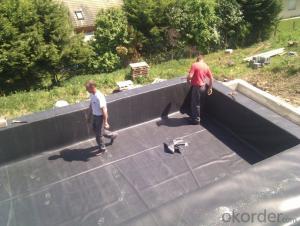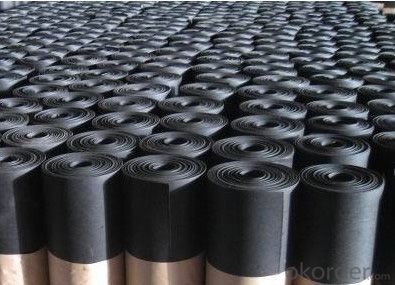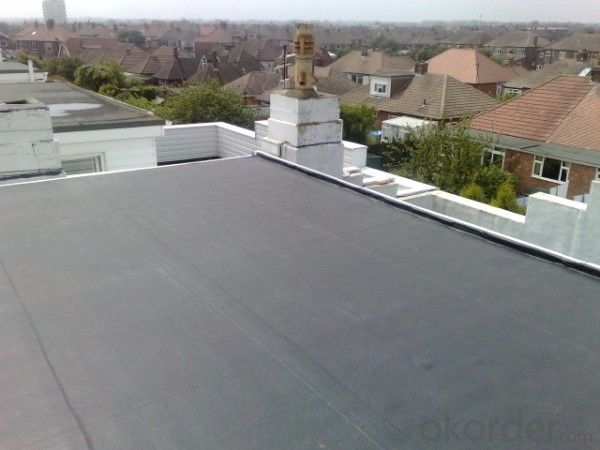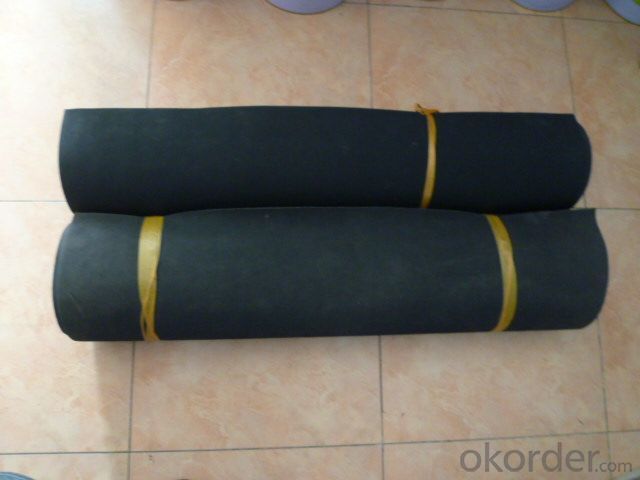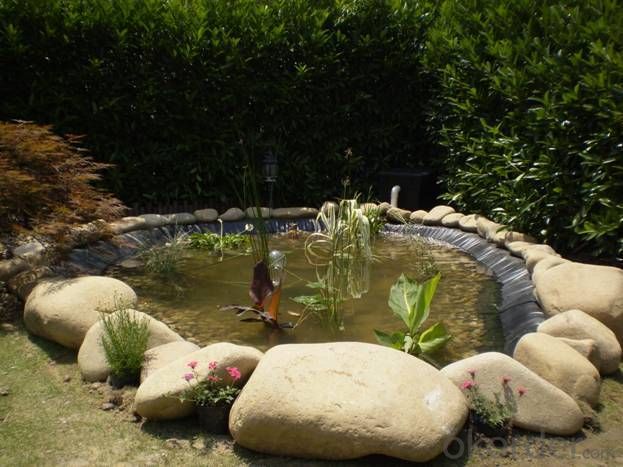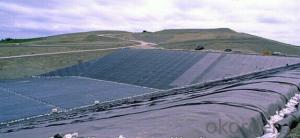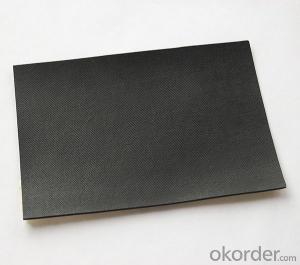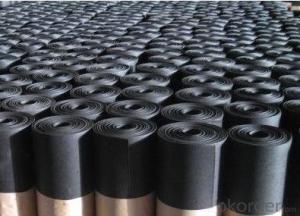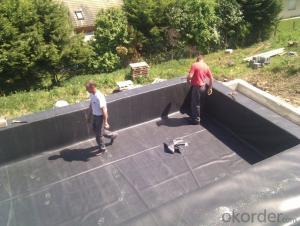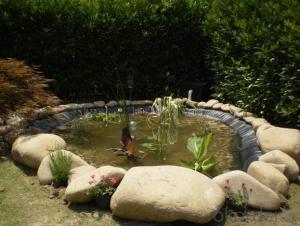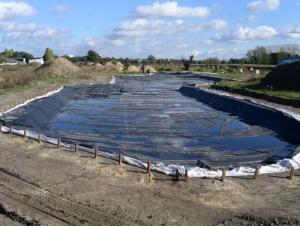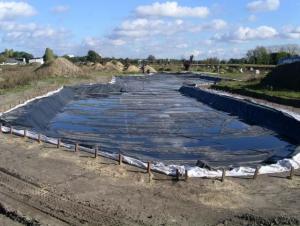EPDM Coiled Rubber Waterproof Membrane for Artificial Pond
- Loading Port:
- Shanghai
- Payment Terms:
- TT OR LC
- Min Order Qty:
- 50000 m²
- Supply Capability:
- 5000000 m²/month
OKorder Service Pledge
OKorder Financial Service
You Might Also Like
EPDM Coiled Rubber Waterproof Membrane for Artificial Pond
Description Of EPDM Coiled Rubber Waterproof Membrane for Artificial Pond:
•EPDM waterproof sheet has excellent anti-ozone-aging performance, able to resist ultraviolet light and corrosion of many chemical corrosive materials in the atmosphere
•It has high tensile strength, high ductility and strong retractility, it has excellent crack resistance, able to effect waterproof function even with tiny vibration of buildings.
• Excellent resistance to ozone, oxidation and sunlight.
• Resistance to chemicals; resistant to most inorganic products.
Main Features of EPDM Coiled Rubber Waterproof Membrane for Artificial Pond:
A.Polyester based SBS Modified Bitumen Waterproofing Membrane
a. Strong impermeability
b. High tensile strength, elongation, ability to adapt the grassroots shrinkage deformation and cracking
c. Puncture-resistant, broken resistant, tear-resistant
d. The corrosion resistance, resistance to mildew, weathering good
e. Construction convenient, hot-melt can be operated Four Seasons Construction, reliable joints
Specifications of EPDM Coiled Rubber Waterproof Membrane for Artificial Pond:
| Material | EPDM Rubber |
| Size | 1.2m (width)*20m (length) or customized, weldable type 2.05m or 4m width |
| Thick | 1.2mm, 1.5mm, 2.0mm |
| Type | Vulcanized & Weldable |
| Pattern | Non-reinforced (homogeneous) |
| Certificate | ISO9001/14001 |
Applications of EPDM Coiled Rubber Waterproof Membrane for Artificial Pond:
1. The substratum should be smooth, dry, clean, which can not have loosing and peeling phenomena.
2. Before application, clean up the basic level and eradicate the impurities.
3. Spread out the membrane on the substratum to loose sheet's stress. Use adhesive-glue to paint the substratum and the surface of membrane. When the adhesive is not sticky to hands, pave and press smoothly.
4. When pave the second volume of membrane, extrude 100mm of the edge of overlap of the first roll and do not paint with the adhesive. Pave the membrane on the substratum according to step so as to finish the whole pavement. When paving, do not tighten the waterproof membrane violently.
5. After that, use the special solvent to scrub the overlap joint. When it becomes fully dry , use the sheet glue to paint the both sides of the joint. Paint it again when it gets completely dry. Till the adhesive is not sticky to hands, press it smoothly and solidly.
6. Pay attention to fire prevention during application. Basement construction site shall be equipped with ventilation facilities



IMages of EPDM Coiled Rubber Waterproof Membrane for Artificial Pond:




FAQ of EPDM Coiled Rubber Waterproof Membrane for Artificial Pond:
1. What are we supplying?
We are specialized in producing Colorful Asphalt Roof Shingle, SBS/APP modified bitumen waterproof membrane, Self adhesive bitumen waterproof membrane, PVC waterproofing membrane, EPDM rubber roofing membrane, Single Component Polyurethane Waterproof Coating, and Spray Polyurea Waterproof Coating
.
2. How Many years experience do we have?
We have been exported to more than 20 countries in the past 15 years.
3. How long do we usually reply your request?
We always reply our customer within 24 hours.
- Q: Are waterproofing membranes resistant to sulfuric acid exposure?
- Waterproofing membranes are generally not resistant to sulfuric acid exposure. Sulfuric acid is a highly corrosive substance that can cause severe damage to many materials, including waterproofing membranes. Due to the strong acidic nature of sulfuric acid, it can react with and degrade the membrane, leading to its failure. Therefore, if there is a possibility of sulfuric acid exposure, it is important to use acid-resistant materials specifically designed to withstand such corrosive substances.
- Q: Is a waterproofing membrane resistant to gasoline or other petroleum-based substances?
- Waterproofing membranes are typically able to resist gasoline and other substances that are petroleum-based. These membranes are commonly manufactured from materials like polyurethane or PVC, which are recognized for their ability to withstand chemicals and petroleum products. This resistance guarantees that the membrane remains intact and effective at preventing water from infiltrating even when it is exposed to gasoline or other petroleum-based substances. However, it is crucial to mention that the actual level of resistance may vary depending on the type and quality of the waterproofing membrane being used. It is recommended to seek advice from a professional or review the product specifications to ensure that the selected membrane is suitable for the intended application involving gasoline or petroleum-based substances.
- Q: Does a waterproofing membrane prevent water infiltration through concrete?
- Yes, a waterproofing membrane can prevent water infiltration through concrete. A waterproofing membrane is a material that is applied to the surface of concrete structures to create a barrier against water penetration. It is designed to be impermeable to water and to provide a protective layer that seals the concrete surface. When properly installed, the waterproofing membrane can effectively prevent water from seeping through the concrete, thereby protecting the structure from water damage and potential structural issues. However, it is important to note that the effectiveness of a waterproofing membrane depends on the quality of the materials used, the installation process, and the maintenance of the membrane over time.
- Q: Can a waterproofing membrane be used for a shopping mall underground parking?
- Yes, a waterproofing membrane can be used for a shopping mall underground parking. Waterproofing membranes are commonly used in underground structures to prevent water infiltration and protect against potential water damage. By installing a waterproofing membrane, it helps to create a barrier that prevents water from seeping into the underground parking area, ensuring its long-term durability and protection against water-related issues.
- Q: Can a waterproofing membrane be used on concrete block walls?
- Yes, a waterproofing membrane can be used on concrete block walls. Concrete block walls are susceptible to water penetration, which can lead to issues such as mold, mildew, and structural damage. A waterproofing membrane is a protective barrier that is applied to the surface of the concrete block walls to prevent water from seeping through. It acts as a barrier against moisture, creating a watertight seal and preventing water from entering the interior of the walls. This helps to maintain the integrity of the walls and protect against water-related damages. However, it is important to ensure that the waterproofing membrane is properly installed and that any existing cracks or gaps in the concrete block walls are adequately sealed before applying the membrane.
- Q: Can a waterproofing membrane be used in combination with insulation materials?
- Indeed, the utilization of a waterproofing membrane alongside insulation materials is highly recommended. This combination offers heightened defense against water damage and moisture infiltration. The waterproofing membrane functions as a protective barrier, preventing water from infiltrating the building envelope, while the insulation materials regulate temperature and enhance energy efficiency. Merging these two components results in a sturdier and more efficient building envelope system. However, it is crucial to verify the compatibility of the selected waterproofing membrane with the insulation materials and adhere to proper installation techniques to guarantee a secure seal and optimal performance.
- Q: Can a waterproofing membrane be used in areas with heavy foot traffic or vehicle loadings?
- In high-traffic or heavy loading areas, it is possible to utilize a waterproofing membrane. Nevertheless, it is crucial to select a membrane specifically designed for such purposes in order to guarantee durability and longevity. These specialized membranes are typically thicker and more resistant to wear and tear. Furthermore, it is important to consider the type of traffic or loading that the area will endure. For instance, areas with vehicular traffic may necessitate a membrane with higher compressive strength to endure the weight of vehicles. In conclusion, the selection of the appropriate type of membrane that satisfies the specific demands of the application is of utmost importance when using waterproofing membranes in high-traffic or heavy loading areas.
- Q: Can waterproofing membranes be used on mechanical rooms?
- Yes, waterproofing membranes can be used on mechanical rooms. These membranes are designed to provide a protective barrier against water infiltration, making them suitable for use in areas prone to moisture or water exposure, such as mechanical rooms.
- Q: Can a waterproofing membrane be used for balconies or decks?
- Yes, a waterproofing membrane can definitely be used for balconies or decks. Waterproofing membranes are specifically designed to protect surfaces from water damage, making them an ideal choice for outdoor spaces like balconies and decks that are constantly exposed to the elements. These membranes are typically made from durable materials such as rubber or polyvinyl chloride (PVC) and are applied directly to the surface of the balcony or deck. They create a barrier that prevents water from seeping into the underlying structure, which helps to extend the lifespan of the balcony or deck and prevent issues like rotting or mold growth. Additionally, waterproofing membranes can also provide added protection against UV rays, chemicals, and foot traffic, making them a reliable choice for enhancing the durability and longevity of balconies and decks.
- Q: Can a waterproofing membrane be used in schools or educational buildings?
- Yes, a waterproofing membrane can definitely be used in schools or educational buildings. Waterproofing membranes are designed to prevent water penetration and protect the building structure from moisture damage. In educational buildings, where a large number of students and staff gather, it is crucial to maintain a safe and healthy environment. Waterproofing membranes can be used in various areas such as basements, roofs, walls, and foundations to prevent water leakage, dampness, and mold growth. By installing a waterproofing membrane, schools can ensure the longevity of their buildings, protect valuable equipment and resources, and provide a comfortable learning environment for students and staff.
Send your message to us
EPDM Coiled Rubber Waterproof Membrane for Artificial Pond
- Loading Port:
- Shanghai
- Payment Terms:
- TT OR LC
- Min Order Qty:
- 50000 m²
- Supply Capability:
- 5000000 m²/month
OKorder Service Pledge
OKorder Financial Service
Similar products
Hot products
Hot Searches
Related keywords
